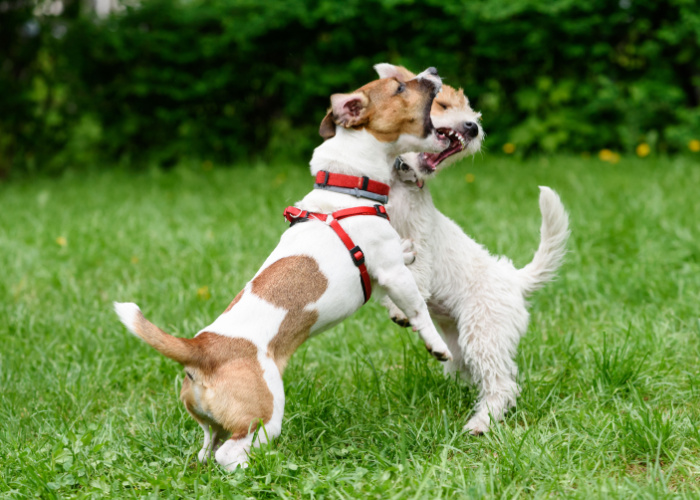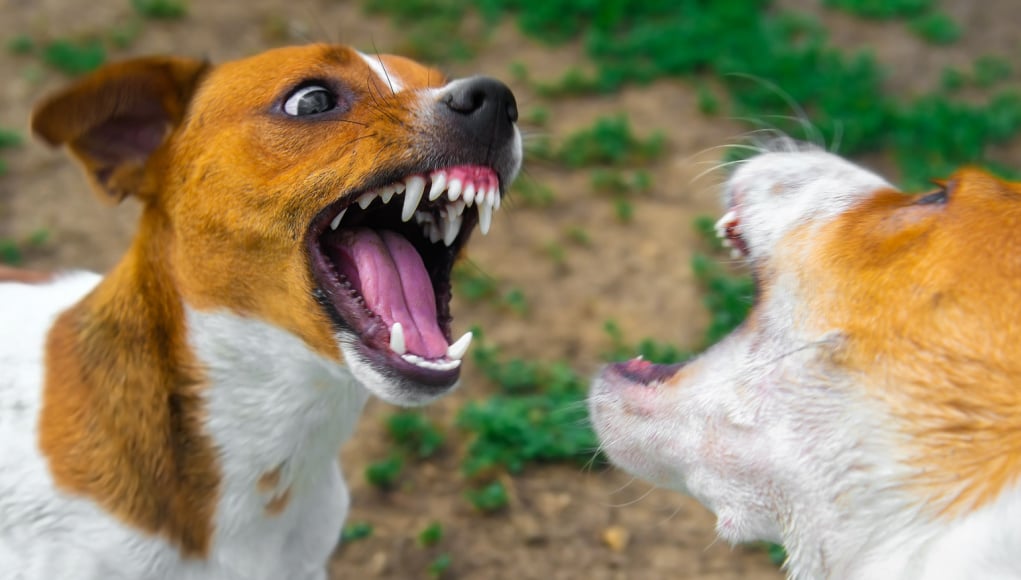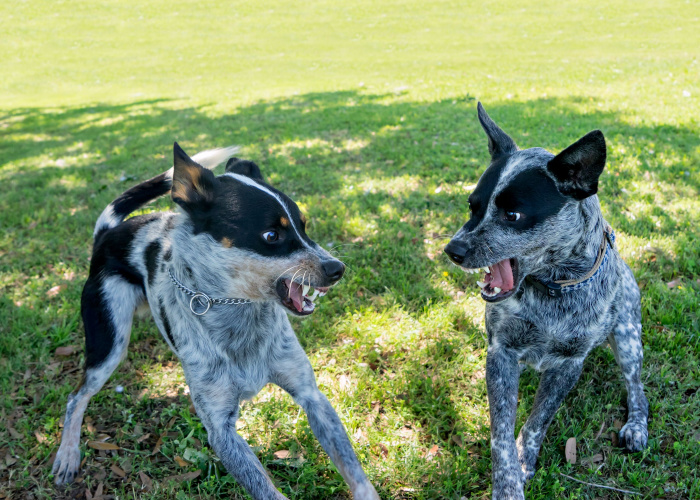Table of Contents
Doggy daycare facilities are every dog owner’s go-to service, especially for those who can’t tend to their pet’s needs at all times.
These facilities provide your dog with adequate food and a space to play while you’re away.
But after picking your pet, you noticed that it’s acting differently after the daycare session.
You even noticed that your dog had become aggressive!
Could the dog daycare session possibly cause this? Is it something that you should be concerned about?
Well, allow me to discuss it with you!
In this blog, I’m here to answer your question, “Can dog daycare cause aggression?”
To answer that, we’ll be talking about the following topics under the question:
- Why Is My Dog Suddenly Aggressive At Daycare?
- How to Deal with Your Aggressive Dogs in Daycare?
- Alternative Services to Dog Daycares
So is daycare making your dog aggressive?
Without further ado, let’s find out!
Can Dog Daycare Cause Aggression?
Now let’s answer the main question of this blog:
Can dog daycare cause aggression?
Yes, dog daycares can induce some aggression in your dogs.
This is because there are a lot of contributing factors in daycares that prompt dogs to be aggressive.
Another scenario possible is that the dog received poor training and socialization inside your house.
So when you put your dog in a daycare, the facility merely brought the problem out in the open.
All of these possible factors are in the next section below.
Why Is My Dog Suddenly Aggressive At Daycare?
Ever got your dog kicked out of daycare because of its disruptive behavior?
Or did the daycare staff call you to report of your pet is constantly trying to pick up a fight with other dogs?
To you, that might come as a shocker, especially if you assumed your dog to be a well-behaved pet when it’s with you.
So it really makes you wonder, “Why is my dog suddenly aggressive at daycare?”
Well, I’ll tell you why.
Here are some reasons why your dog is suddenly aggressive at daycare.
1. Dog Fight
Dog fights are inevitable in a doggy daycare, no matter how prepared the staffs are in preventing one.
So when a fight breaks out and your dog is involved, it will be a traumatic experience for your dog.
Traumas of dogs, according to Pia Silvani of ASPCA’s Behavioral Rehabilitation Center:
Can also manifest as shaking, hiding, urination, and or defecation when the trigger attempts to interact, howling, pacing, excessive vocalization, and panting.
But do you know another way dogs show their traumas?
It’s by becoming aggressive.
Dogs develop fears and anxieties from the trauma which then initiates them to become aggressive.
2. Injury or Wounds
When was your last injury?
Do you remember how you flinch and lash out at everyone when your injured area was moved or touched?
That’s right, those injuries agitate you because of the pain.
Like you, dogs can get agitated and defensively aggressive when someone tries to touch and move the injured part.
Who wouldn't react like that, right?
And most likely, a lot of playful dogs in the doggy daycare will accidentally move the injured area.
You can imagine how your dog would react because of how painful its injuries are.
RELATED: How To Treat A Dog Wound: Quick Video Guide
3. Illness
If a dog is sick, it should focus on resting and recovery.
That’s why, like injuries, it’s a natural response to feel aggressive and agitated when your dog is disturbed.
4. Learned Problem Behavior
Monkeys see, monkeys do.
Your dog is not a dumb creature.
It can acquire and learn aggressive behaviors in the dog park just from interacting with aggressive dogs in the daycare.
Aside from aggressive dogs, your dog can also learn it from a dominant leader dog figure in the daycare.
As Stanley Coren, PhD., DSc, FRSC wrote:
Puppies show tendencies to imitate the behaviors of others from an early age and this continues throughout their lives. It appears that many socially significant behaviors are learned as a result of participating in such organized social behaviors.
5. Separation Anxiety
Separation anxiety is one of the most common reasons why dogs get aggressive in a doggy daycare.
As the name suggests, separation anxiety is when your dog suffers from stress and anxiety whenever you are separated from them.
Patricia McConnell, PhD., a Certified Applied Animal Behaviorist added:
Although we can’t know for sure what’s in a dog’s mind, we can think of Separation Anxiety as the equivalent of a panic attack.
So obviously, anxiety can induce your dog to feel agitated and invoke fear-aggressive behaviors and actions.
6. Bad Experience at the Daycare
A bad experience and potential source of trauma don’t need to come from dog attacks.
It can also come from any source too!
Maybe a staff might’ve scared the dog, whether intentionally or not, so the pooch will be vigilant and defensive inside the daycare.
Perhaps the dog got hurt in an incident while still in the daycare.
Whatever the source of the bad experience is, it will soon develop coping mechanisms which include becoming aggressive.
RELATED: 15 Facts About Fear Aggression in Dogs
7. Resource Guarding
Resource guarding is a behavior that triggers when dogs assume ownership of a thing or food.
You can see this behavior manifest when your dog starts growling, lunging, or starts biting whenever someone gets close to its food or toy.
In a dog daycare setup, a lot of dogs doing resource guarding can quickly escalate into ferocious dog fights.
But before anything lethal happens, the staff of the dog daycare prevents any aggression from buildup between dogs.
Nicole Costanza, an AKC Evaluator also affirms other dog body languages to further tell if your dog is resource guarding.
These include:
- Stiffening of body posture
- Unbothered laser-focus stares
- Whale eye
- Lips lifting
- Soft growling noises
- Teeth baring to target
Costanza also said that any dog can be prone to resource guarding and it’s not specific to one breed.
Instead, she notes:
It all depends on the individual dog. The environment a dog grows up in could also dictate whether they have resource-guarding issues or not.
8. Overstimulation
Some form of stimulation is important for dogs because it entertains their senses and boredom.
But too much stimulation can also be bad for them.
When there’s sensory overload, dogs can become hyperactive and aggressive in behavior.
Conversely, some dogs are reactive, meaning even the most common stimuli can excite them.
Their reactiveness to stimulations can also cause overstimulation which then leads to your dog’s aggressiveness.
Unfortunately, dog daycares are full of stimulation, especially for first-time users of the facility.
These trigger stimulations can quickly flood your dog's senses, making them confused and aggressive.
9. New Environment
Putting your dog in a new place also increases the chance of them becoming aggressive.
How? Well, a new place means new things to stimulate them.
Everything and anything within the new environment brings a lot of fresh sensory experiences for your dog.
From the smell, noise, and objects to chase, and down to the new people to interact with, the new environment gives your dog something to be excited about.
Sometimes they become too excited with the new things in their environment, resulting in hyperactivity and aggression.
And this is exactly what happens to dogs during their first visit to dog daycares.
On the other hand, some dogs don't get excited in a new environment but feel distressed instead.
New places mean uncertainty which brings anxiety to your dog.
And when dogs are anxious, they become increasingly defensive and aggressive.
How to Deal with Your Aggressive Dogs in Daycare
Having the doggy daycare kick your dog out of the facility can be an unpleasant experience for you and your dog.
And you might lose your trust in dog daycare services because of this incident with your dog.
But the thing here is it’s your dog that’s a threat in the daycare.
After all, if your dog is suddenly getting aggressive in the daycare, it can attack other dogs inside the facility.
So what do you do?
If your dog is acting differently in daycare, you first need to identify what’s causing your dog to be aggressive.
Knowing the cause of your dogs going hostile is important to apply the right approach to dealing with it.
After identifying the source of the problem, you either remove it or change your dog’s behavior with training.
Here are some ways of dealing with your dog’s aggression in daycare.
1. Moving to a New Dog Daycare
Yes, it’s not always your dog’s fault why it’s become increasingly aggressive in the daycare.
Some dog daycares may not accommodate your dog well inside their facilities.
This often leads to poor handling of their client’s pets.
For example, if there are not enough daycare staff to supervise dogs, an accident or even a dog attack may break out.
Dog bullying will also be left unattended because of the low staff-to-dog ratio.
And if the daycare staffs are untrained individuals, they can cause more problems than what’s already present.
So if the current doggy daycare brings nothing but bad experiences for your dog, just find a new one.
Find a doggy daycare that has a promising environment and accommodating staff that can tend to your dog’s needs.
RELATED: What to Look for in Top Dog Daycare and Boarding
2. Training Socialization
Socializing and exposing dogs both to humans and other dogs is extremely important in shaping their behaviors.
And it’s never too late to socialize them even at their adult stage!
Having your dog socially trained is crucial in social areas like a doggy daycare facility.
After all, your dog will inevitably engage with fellow dogs in the facility.
The staff will also check in on your dogs from time to time.
And if your dog is well-socialized with other creatures, they become more confident and less aggressive in new environments.
So, wouldn’t it be nice if your dog is used to interacting with other creatures?
3. Desensitization and Counterconditioning
Decreasing the exposure to stimuli is the most intuitive way to lessen the symptoms of your dog’s sensory overload.
If your dog is getting overstimulated by loud noise, cranking the volume down stops it from becoming stimulated.
The same goes for any reactive dogs in dog daycares—or even dogs with traumas.
If you remove the things that could trigger them, you’ll also be removing their aggressive behaviors in the daycare.
It’s a straightforward solution for a plain problem, right?
Unfortunately, that’s not the case.
What you’re doing is simply avoiding the problem, not actually treating it.
If the trigger stimuli return, then your dog is back from becoming overstimulated again.
So how do I help with my dog’s overstimulation?
Well, the best way to counter external stimuli is with desensitization and counter-conditioning.
Desensitization simply means gradually exposing your dog to stimuli that would trigger a bad reaction from it.
For example, the presence of a new face can be a trigger for your dog to bark profusely and aggressively.
To desensitize your dog, the stranger should start at a distance where your dog can see them but won’t bark.
From there, they should close their distance from the dog without triggering them to bark.
The stranger should work its way until they could approach your dog with ease; better, pat your dog’s head.
Conversely, counterconditioning is pairing trigger stimuli with rewards to make the dog feel good while being exposed to the trigger.
A great example of counterconditioning is when the stranger continuously brings treats to your dog.
Instead of feeling alarmed and agitated, they would associate positive emotions with the sight of the new person.

Alternative Services to Dog Daycares
Dogs are not always the daycare type, so you can’t expect them to love the setup all the time.
And if your dog is still being aggressive inside dog daycares, then this type of dog care service is not for them.
Luckily, there are still alternatives should you still need someone to take care of your dogs while you’re away.
Dog Walker
If you need someone to keep your dog occupied for a brief period outside, then a dog walker might be for you.
As the name implies, dog walkers take your dog outside and walk them within the vicinity.
Dog walkers often take your dog to parks and walk them along the streets of your area.
When they do, dog walkers bring much-needed exercise and stimulation to your dog.
Dog Sitter
If babies have babysitters, then dogs have dog sitters!
Dog sitters are hired to take care of your pet dog inside your house while you’re away.
This type of service is for dogs that prefer the home setup rather than daycares or dog boarding.
So if your dog is acting aggressive in daycares but is well-behaved in your home, it’s a telling sign to go for dog sitting instead.
Dog Boarding
If you are away from your dog for a couple of days and nights, then consider enrolling your dog in a dog boarding service.
Dog boarding services often include facilities for dogs that will stay overnight.
Comparing this service to doggy daycare, boarding allows owners to leave their dogs for more extended periods.
Boarding services can also include separate kennels for each dog, which makes dog fights virtually impossible.
Can Dog Daycare Cause Aggression — Final Thoughts
Can dog daycare cause aggression?
Yes, they can, since there are a lot of factors in the daycare that can change your dog’s behaviors.
Luckily for you, your dog’s aggressive behaviors can still be modified or corrected with the proper conditioning techniques.
Alternatively, you can also choose another daycare that can better accommodate you or resort to other dog care services.
Make sure to arrange the right dog care services for your pet to ensure that your dog receives ample amounts of care even while you’re away.
If you found this blog helpful, you might want to check out related articles about doggy daycares below!
















